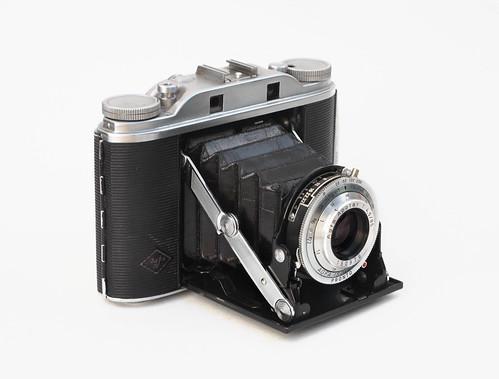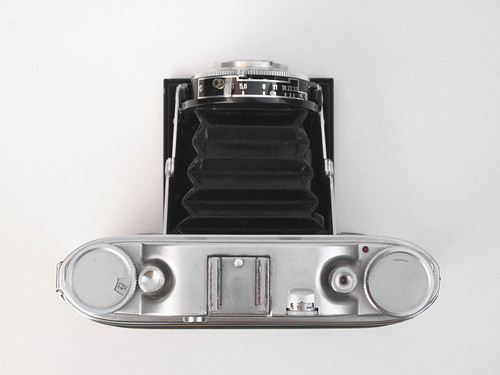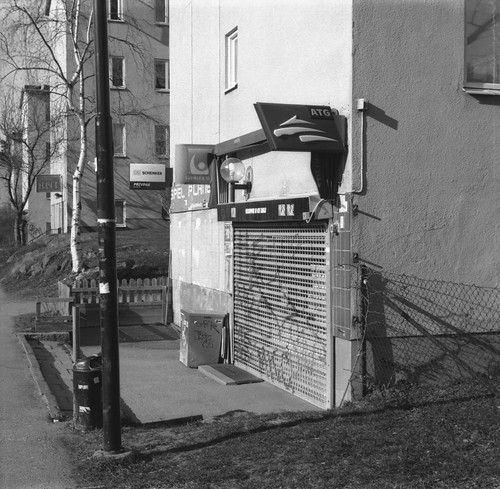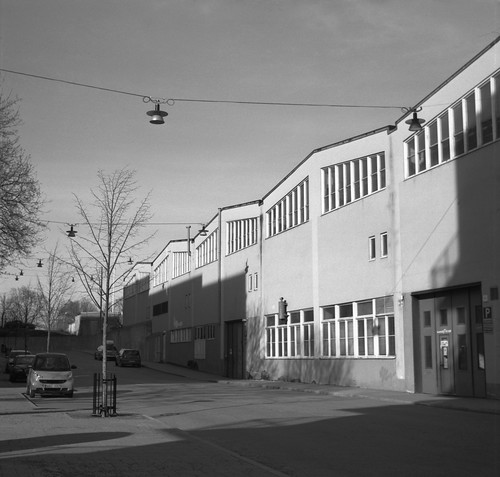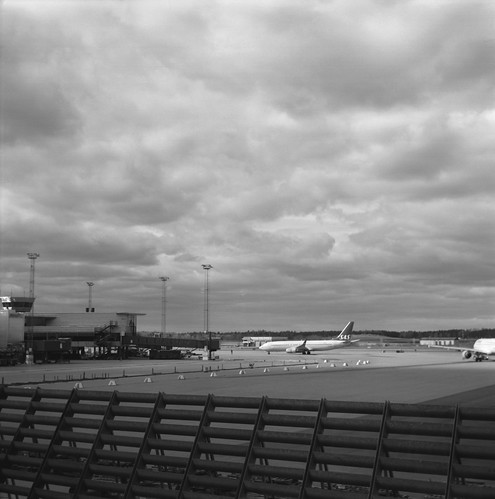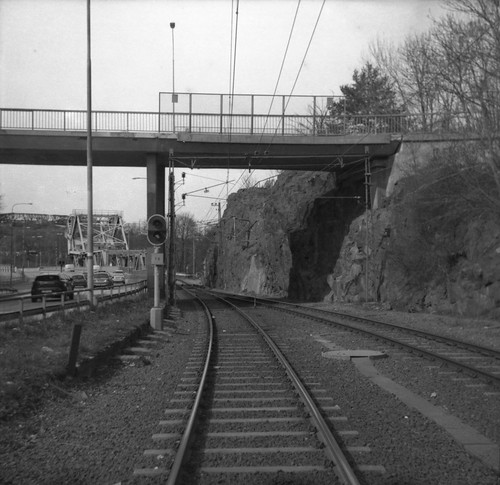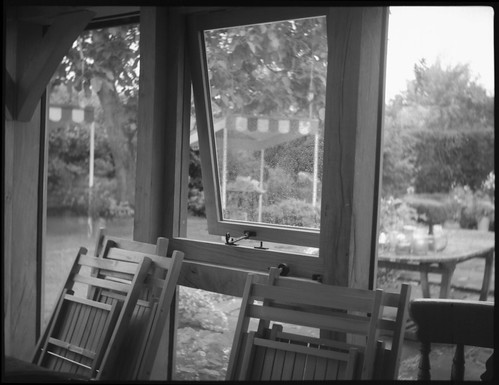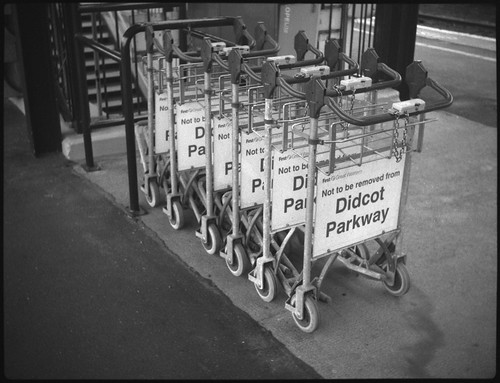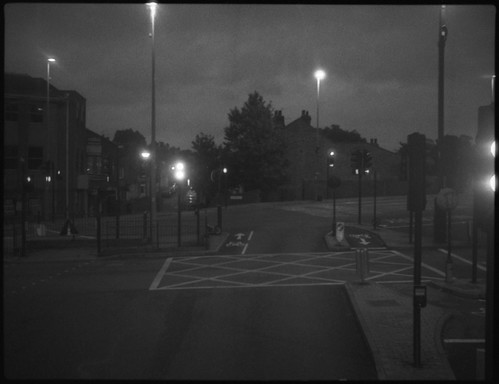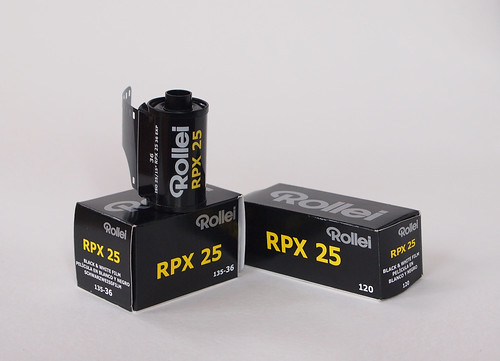 |
| Rollei RPX 25 in 35mm and medium format |
Having reviewed both
Rollei RPX 100 and
400 in recent months, as Maco also introduced a new low-speed fine grain
Rollei RPX 25 at the end of last year, I wanted to test this film too. Like the 100 and 400 ISO versions, it's available in 35mm and medium format, and all films have now been repackaged, in cartons instead of the plastic containers prevously used, and the 35mm cartridges now have DX coding. Previously the 100 and 400 speed films, like other 'Rollei' branded films from Maco, had printed adhesive labels affixed to uncoded generic cartridges. The new packaging suggests that Maco are investing resources in their RPX range for the foreseeable future. Maco have been known for buying stock from other manufacturers, rebranding and repackaging film, and when RPX 100 and 400 appeared, there was much speculation online about its similarities to Harman's
Kentmere 100 and
400 films. While there is currently no data sheet available from Maco for Rollei RPX 25, on
Macodirect the new film is described as:
...a low-speed panchromatic black and white film with a nominal sensitivity of ISO 25/15° [...] Rollei RPX 25
is characterised by a high sensitivity reserve of one f-stop,
depending upon development. The thin-section document-emulsion is
poured onto a highly transparent base and offers an extraordinary
sharpness, with finest grain.
As I have done for the other two RPX films, for a first roll in 35mm, I wanted to test the film for latitude. Shooting the film with a Praktica MTL3 camera, I shot the frames on the first and second rows with exposure indexes of 6-12-25-50-100-200; the frames on the third row were all shot at a rating of 25. I developed the film using the manufacturer's recommendation of 6 minutes in R09 One Shot (Rodinal) diluted 1+25 at 20ºC.
 |
| Rollei RPX 25 latitude test contact sheet |
I also shot a second roll at 25 ISO. I used a yellow filter on some of the shots which included the sky. The second roll was also developed in Rodinal, but this time diluted 1+50 for 11 minutes at 20ºC, an alternative recommendation for the film.
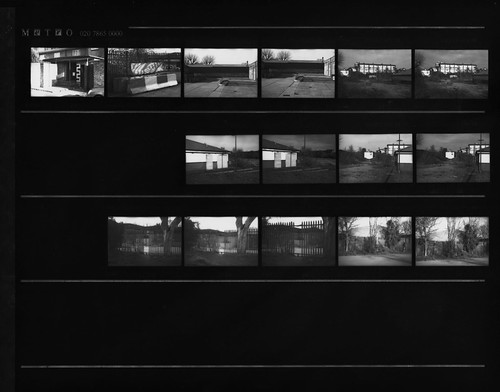 |
| Rollei RPX 25 film test contact sheet |
My first impressions from developing these two rolls were that Rollei RPX 25 has very different qualities from RPX 100 & 400: it was immediately clear that the negatives were of high contrast; the film base was very clear and tough (I was unable to tear the film). The film also dried very flat, there being almost no curl to the negatives once cut. When printing the contact sheets on Kentmere VC Select paper, I tried making the contact prints without using a multigrade filter, meaning that the contrast should be in the middle of the paper's range, but the contrast was too high with almost no detail showing at either extremes of the latitude tests. I reprinted the contact sheets with a 00 multigrade filter for the minimum of contrast, as with the sheet shown above. As Rollei RPX 25 does not demonstrate the wide latitude of the other RPX films, exposure needs to be more exact, and, I suspect, it also requires more careful development.
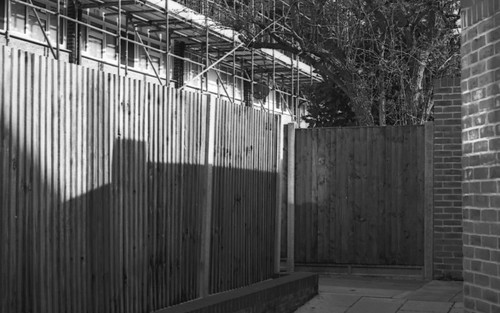 |
| Rollei RPX 25 at box speed, developed in Rodinal 1+25, 6m at 20ºC |
In scanning the negatives, I was able to supress the extremes of the film's inherent contrast and pull detail out of both shadows and highlights, which may not be as easy to do when printing in the darkroom. The above image I shot for the latitude test specifically because the scene showed a very wide contrast range, and would be ideal for testing this (however, the brick wall, also shot for the latitude test, was not as good a subject, tending with underexposure to look more graphic and linear). In terms of grain, the flatbed scanner I used wasn't capable of resolving its fine detail. The latitude test appears to show that highlight detail is quickly lost with overexposure; in the
shot of the daffodils, not a great photograph by any means, the highlights are almost entirely featureless, but with less exposure the shadows would have suffered. The film developed with a dilution of 1+50 may have had slightly less contrast, but this was hard to judge as the lighting conditions were different: although many of the scenes are lit by the sun, it was later in the afternoon.
 |
| Rollei RPX 25 at box speed, developed in Rodinal 1+50, 11m at 20ºC |
I wasn't entirely happy with the results of the first two films in general, although some individual shots were better than others. Due in part to shooting the film on a bright sunny day, the inherent contrast of the film was problematic regardless, and I felt the manufacturer's recommendations for exposure and development were some way off giving satisfactory results. I wanted to try reducing the contrast by developing with a higher dilution of Rodinal. Although the general strategy when attempting to achieve pictorial contrast with document-type emulsions (such as the
Ilfodata HS23 film, and
Rollei ATO 2.1 - and Maco's own publicity describe RPX 25 as having a "document-emulsion") is to expose more and develop less, with the highlights in danger of blocking out at box speed, such as in the frames rated 12 and 6 in the latitude test, I wanted to try rating the film at 50 to avoid this. Maco's own quote is that RPX 25 has a "nominal sensitivity of ISO 25" with a "high sensitivity reserve of one f-stop" could be read that the film's true ISO is more like 50, but with exposure recommended for 25.
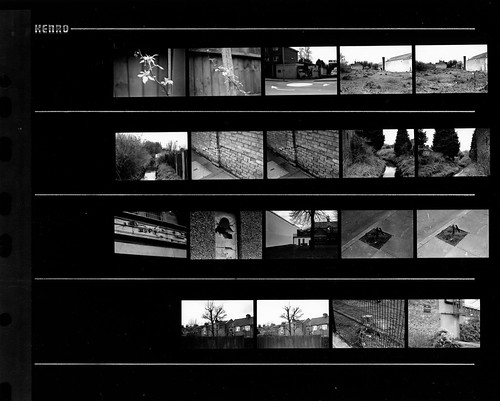 |
Rollei RPX 25 stand development film test contact sheet
|
I shot another two rolls of 35mm, one with my Olympus OM10, rating the shots at 25 and 50, and some at an intermediate exposure index of 32, and another film in the
Kodak Retina IIa. For the film from the OM10, I used stand development in Rodinal diluted 1+100; the film from the Retina was developed with Rodinal diluted 1+150, but for 12 minutes at 20ºC with normal agitation, a much higher dilution than the 1+50 recommended. At the point of hanging up the negatives to dry I could see that the results were better, with the film developed at 1+150 looking a bit thin; subsequently scanning these negatives was much less trouble than the first two rolls, where I found it difficult to keep highlight detail without making the lower range of midtones lose separation, leading these to become muddy. With a higher dilution of film developer, the highlights were easier to control, although with the stand developed negatives, the shots that had areas of sky within the frame showed these as virtually featureless, and attempting to recover or preserve detail in the scanning caused problems with halos around the branches seen against the sky. The negatives developed at the dilution of 1+150 were better in this regard. Nevertheless, with these dilutions I printed the contact sheets striaght without reducing the paper's contrast.
 |
| Rollei RPX 25 at box speed with stand development in Rodinal 1+100 |
 |
| Rollei RPX 25 at EI 32 with stand development in Rodinal 1+100 |
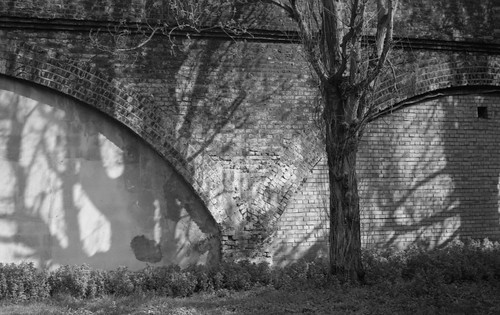 |
| Rollei RPX 25 at box speed, developed in Rodinal 1+150, 12mins at 20ºC |
Feeling that the developer dilution of 1+150 was close to the result I wanted, I shot a roll of RPX 25 in medium format with a
Voigtländer Bessa RF, rating it at around 25 using the 'sunny 16' rule for exposure (I noticed that medium format RPX 25 has identical backing paper to Ilford's 120 films, unsurprising perhaps, being made in conjunction with Harman, but the older packaged versions of RPX 100 and 400 had different backing paper, with instructions in both English and German: at the end of the roll there is the injunction 'Hier Falten/Fold Here'). I modified my times and dilutions from the previous 35mm roll, and developed the medium format film in Rodinal at 1+120, for 14 minutes at a lower temperature of 18ºC.
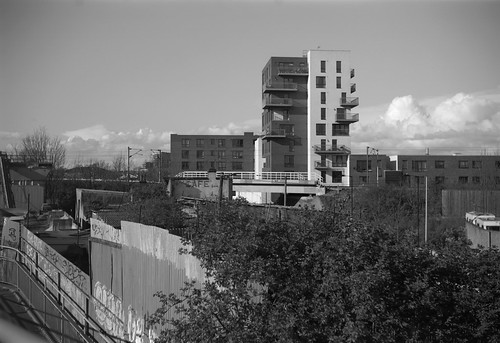 |
| Rollei RPX 25 (medium format) at box speed, developed in Rodinal 1+120, 14mins at 18ºC |
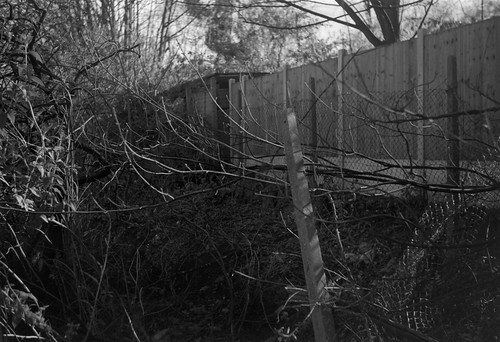 |
| Rollei RPX 25 (medium format) at box speed, developed in Rodinal 1+120, 14mins at 18ºC |
The results from the medium format roll appeared to show that extending development time while lowering dilution, and perhaps importantly temperature, brought less extreme contrast to the tonal range, while keeping good tonal separation. Incidentally, using a pre-war uncoated lens with these medium format shots may have also helped with the contrast a little - I had hoped for an overcast day with flat lighting to shoot the medium format film based on the previous 35mm tests, but highlight detail has held up well. Even with the bottom-of-the range Helomar lens, the negatives hold a huge amount of detail - with the shot below, it's possible in the original scan to count all the bricks in the building in the centre between the two high rise blocks, which promises well for prints made optically, as opposed to flat-bed scans.
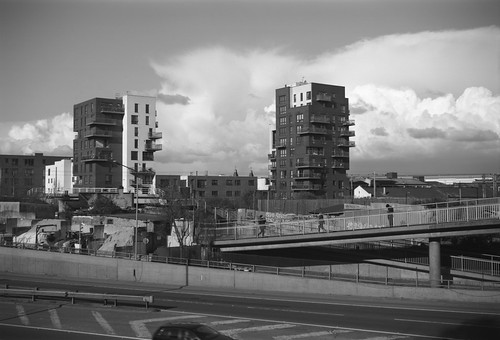 |
| Rollei RPX 25 (medium format) at box speed, developed in Rodinal 1+120, 14mins at 18ºC |
Rollei RPX 25 is very different from the two faster films that share the RPX name, different enough that for Maco to use the RPX label for this film feels misleading. Both Rollei RPX 100 and 400 are much more flexible films where the recommended exposure and development times give good results with a variety of shooting conditions; from my tests RPX 25 needs far more careful exposure and development to bring out its own distinctive qualities of sharpness and fineness of grain without losing tonality to its high contrast. As a film photographer, while other emulsions are being discontinued, it's heartening to see new products appearing; as a low-speed fine-grain film, Rollei RPX 25 may well not be a good choice for a general all-purpose black and white film, but for the right subject conditions, with attention to exposure and development, it does provide beautifully sharp and clear results.
